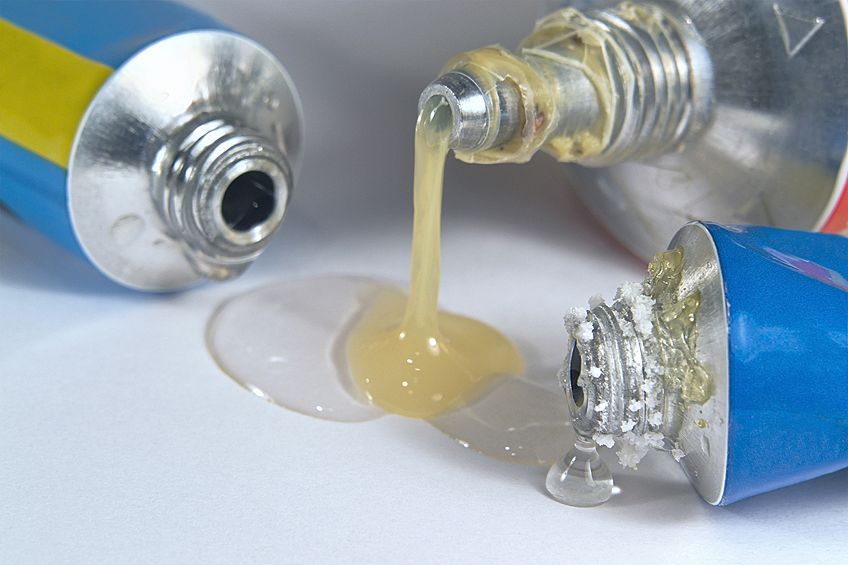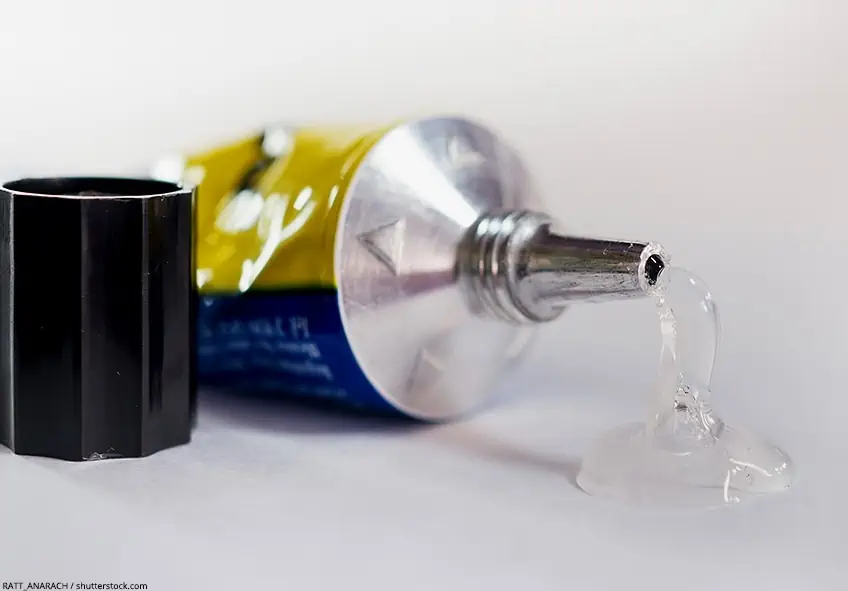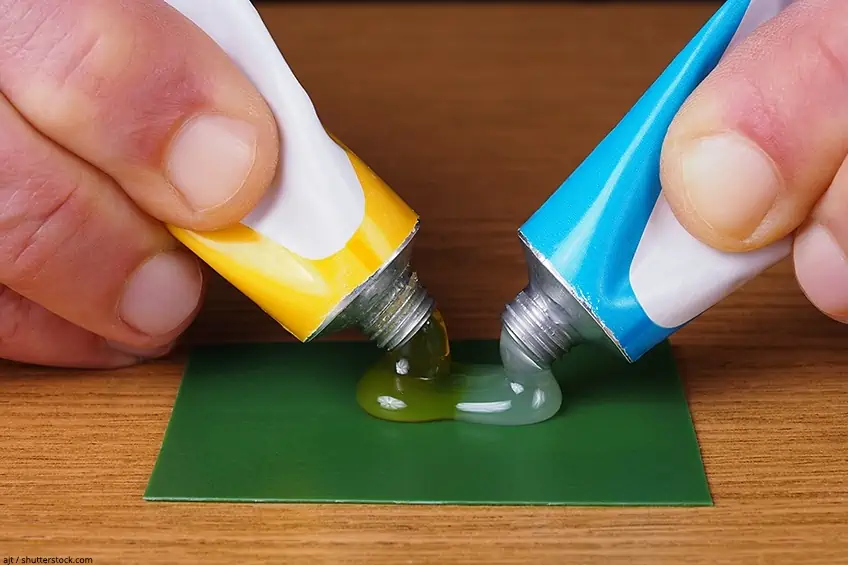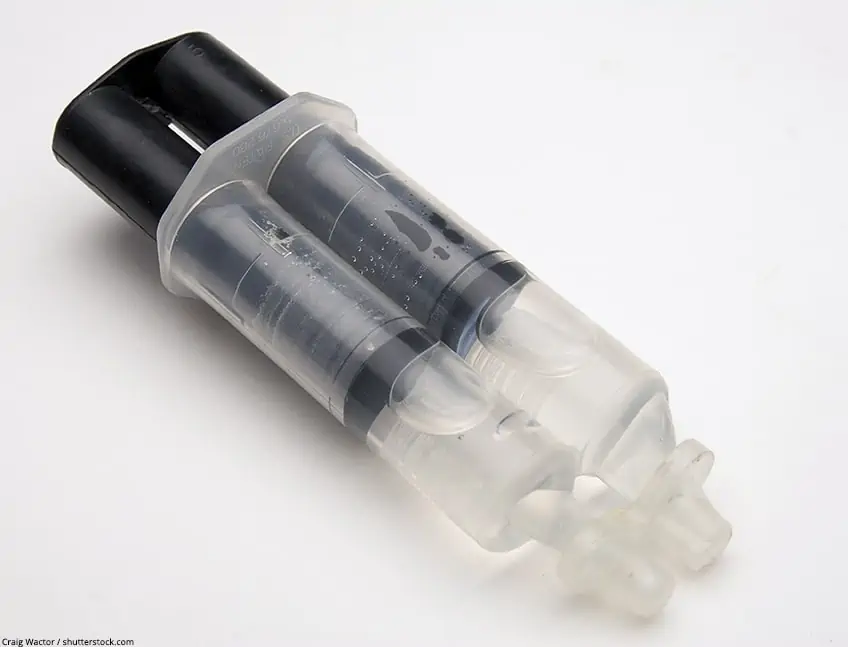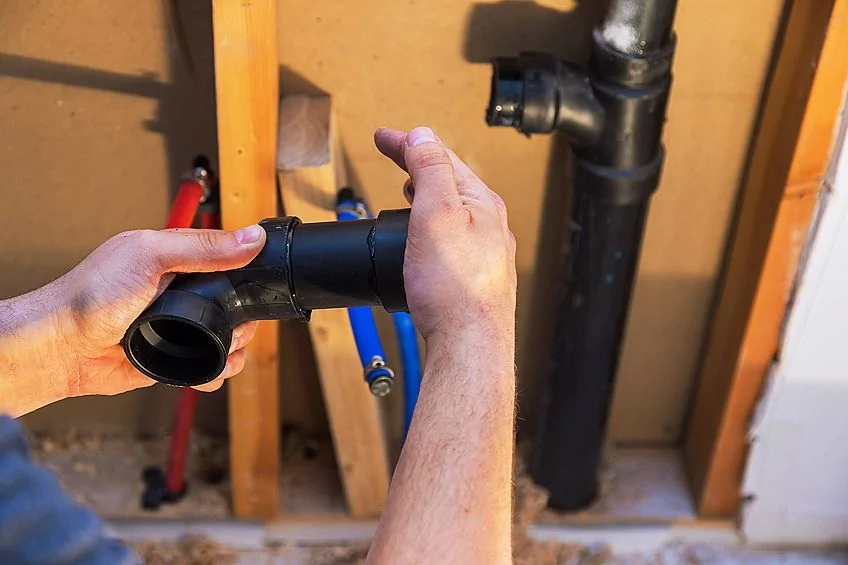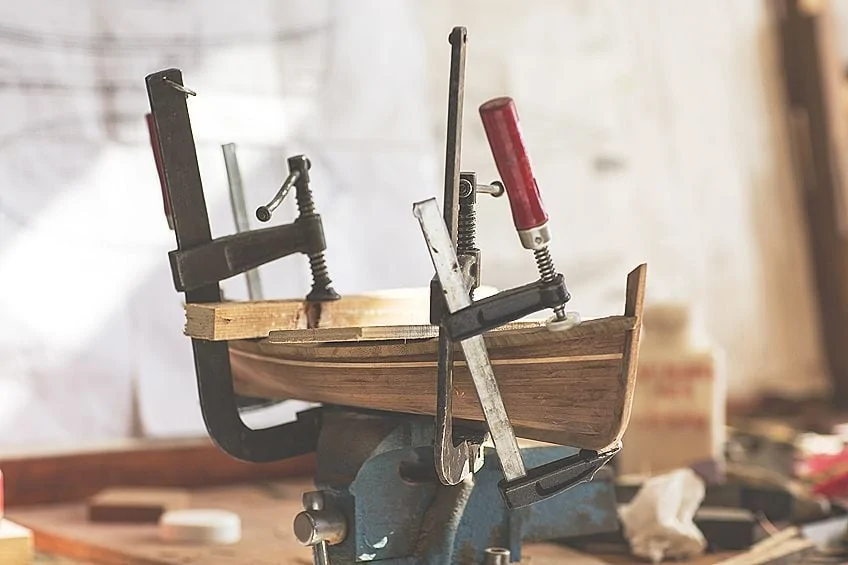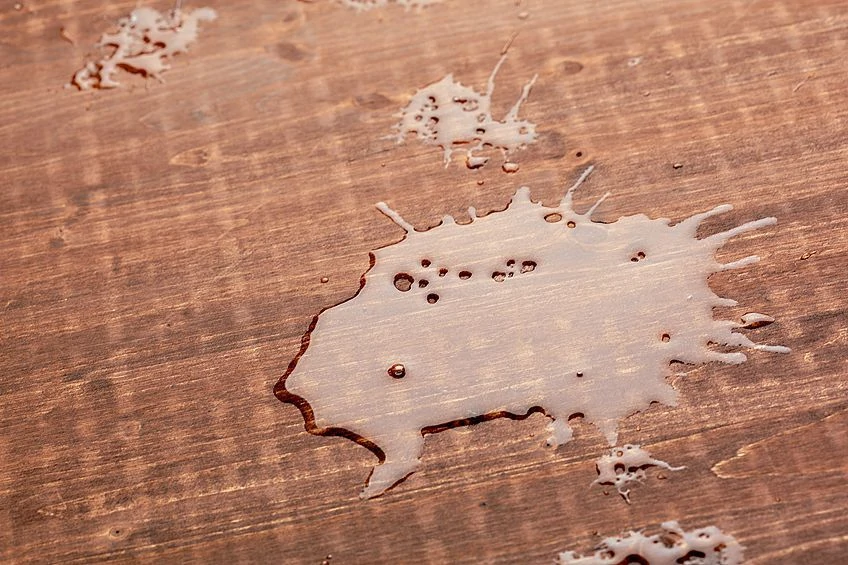Epoxy Glue Guide – Exploring the Versatility of Epoxy Adhesive
This post may contain affiliate links. We may earn a small commission from purchases made through them, at no additional cost to you. You help to support resin-expert.com
If you are a passionate do-it-yourselfer or work professionally with different materials, you will not be able to avoid the question of the right adhesives. The repertoire of adhesives is no longer limited to well-known pens and superglues. For every conceivable application, there seems to be a different type of adhesive – a fact that can easily cause confusion. In our 2-component adhesive test, we advise you on this and introduce you to an adhesive that scores with its many advantages: epoxy resin adhesive.
Table of Contents
What Is Epoxy Glue?
If you are looking for glue with high durability and strength, then an epoxy adhesive may be your best option. Epoxy glues are typically used for painted and pre-treated metals or other composite materials. If you have experience with epoxy resin, then you will be familiar with the two-part construction of epoxy adhesive. Containing a hardener and resin in the correct mixing ratio, epoxy adhesives create strong and high-tensile bonds. These bonds are extremely stable and cannot be changed by mechanical or thermal effects.
Two-Part Epoxy Glues
Before you can use epoxy glues you will need to mix these two components in a 1:1 ratio to create a strong bond. Depending on the brand of epoxy glue that you buy, this can be done in an instant mix syringe or on a tray or durable surface. Once you mix these two components, your working time begins. Working time is the time that you have to apply your adhesive and adjust your surfaces before the glue hardens and the bond becomes permanent. Depending on your choice of glue and other environmental conditions like heat and humidity, this working time can vary from minutes to hours.
Once your working time is up, your bond will still require several hours before it reaches its maximum strength.
One-Part Epoxy Glues
If you do not have time for the faff of mixing your resin glue yourself, you can purchase pre-mixed epoxy adhesive. The application of pre-mixed epoxy resin glue is significantly easier and quicker. You can spend more time working and less time preparing your glue. They do, however, require a higher curing temperature to reach their full bonding potential. The cure time for pre-mixed epoxy adhesives is relative to the un-mixed options, still requiring around six hours.
Applications of Epoxy Resin Glue
One of the greatest features of resin glues is their versatility. Whatever your project, whether metal, plastic, wood or building materials, you will find a suitable resin glue. Typically, you can use one-part or two-part epoxy adhesives for most applications, but some materials are better suited to either one or the other. You can also cure your resin glue in two different ways, depending on the speed that you require. Room temperature curing is the most common and can take up to 6 hours.
If you are looking for more speed, or you are working with one-part epoxy, you can use thermal curing.
Another great thing about epoxy adhesive is that it is very resistant to weathering and many environmental forces, including temperature, UV, and water. You can use epoxy resin glue on a range of surfaces inside and outside, from construction to boat building to water pipes. Here is a summary of the surfaces that epoxy resin glue can be used on, as you can see, it is one of the most versatile adhesives available.
| Surface Type | Suitable? |
| Metal | ✔ |
| Wood | ✔ |
| Plastic | ✔ |
| Concrete | ✔ |
| Styrofoam | ✔ |
| Fiberglass | ✔ |
| Glass | ✔ |
| Ceramic | ✔ |
Our Recommendations for Epoxy Glues
Whatever your project, there will be an epoxy adhesive perfect for you. In this section, we have summarized three of the best resin glues on the market to help you make your final decision. There are both one-part and two-part epoxy adhesives in this list, and all of them are versatile and suitable for almost all necessary surfaces.
The Best Reinforced Epoxy Resin Glue: J-B WELD Cold-Weld Reinforced Epoxy
If you are working with a metal surface, then this J-B Weld epoxy adhesive is probably your best bet. Although it is a two-part epoxy requiring hand-mixing, this steel-reinforced epoxy glue is a fantastic alternative to torch welding. You can use this resin glue to provide strong, durable repairs to metal as well as wood, fiberglass, concrete, and ceramic surfaces. After mixing your resin glue, you will need to leave your project to set for 4-6 hours, and an additional 15-24 hours to cure fully. Once cured, this epoxy adhesive is petroleum, chemical, acid, and water-resistant.
- Provides long-lasting and durable repairs to multiple surfaces
- Sets in 4-6 hours and cures fully in 15-24 hours
- Waterproof, petroleum, chemical, and acid-resistant when cured
PROS
- Extremely durable
- Water, acid, chemical, and petroleum-resistant
- Suitable for a range of surfaces
- Stronger than a steel bond
CONS
- Requires hand mixing
- Long cure time
- Dries gray
Best All-Purpose Epoxy Resin Glue: GORILLA 2 Part Epoxy
The Gorilla 2 part epoxy glue offers all the properties you are looking for in such a product: it is easy to apply, can be used indoors and outdoors, and bonds almost all materials: plastic, glass, metal, wood, leather, cement, porcelain and many other surfaces. It is BPA-free, i.e., it does not release any bisphenol, which is particularly important when it comes into contact with food. This is one of the best epoxy adhesives for tough repairs.
- Strong, permanent, fast, and gap-filling epoxy glue
- Cures quickly, dries, clear, and is great for multi-surface application
- For tough repairs requiring a durable bond and solvent resistance
PROS
- Strong
- Permanent
- Dries clear
- Easy-to-use syringe
- Includes cap for multiple uses
- Versatile
- Durable bond
- Solvent-resistant
CONS
- Takes a long time to cure fully
Best Instant Mix Epoxy Resin Glue: LOCTITE Instant Mix Epoxy
If you are looking for a quick fix, self-mixing epoxy glue applicator, then this is a fantastic option. The double syringe applicator has a convenient and precise self-mixing nozzle that produces a tough, high-strength, and rigid bond. The Loctite epoxy glue sets in only 5 minutes and can be handled in an hour. You can also sand, drill, and paint over this high-impact resistant glue. You can use this glue on a range of materials, including ceramic, stone, tile, plastics, metals, and wood.
- Quick fix, a self-mixing applicator for use on a range of materials
- Self-mixing nozzle conveniently and precisely dispenses glue
- High-speed epoxy sets in just 5 minutes for quick repairs
PROS
- Versatile
- Quick drying
- Precise nozzle
- Self-mixing
- High-impact resistance
- Rigid bond
CONS
- On the expensive side
General Guidelines for How to Use Epoxy Glue
Two-component adhesives are usually available in double chamber cartridges. This means that the two components are not mixed until directly before use. Today’s technology allows a clean and easy application. Here are some general pointers to follow when using 2 part epoxy glue on almost all surfaces:
- Roughen your surface to promote adhesion. You can use a sander for this purpose.
- Clean your surface thoroughly, removing grease and other dirt. You can do this with a cleaning agent and lint-free cloth.
- Do not touch the surface after cleaning, as the greasy film from the skin can disrupt the adhesion.
- Depending on the type of applicator, break off the syringe tip and add the mixing attachment.
- Gently press the plunger to remove any air bubbles, without squeezing out any of the glue.
- Apply the required amount of adhesive to the surface. Apply as little as possible, to prevent any escaping from the side seams.
- Join the surfaces together and fix them in place. You can use a vice, sturdy tape, or a clamp.
- Clean the syringe immediately, and then put the plunger back on and remove the mixer.
- Scrape the residue from the syringe, and wash the tip with hot water before re-applying the cap.
- Wait the required time before moving your object, to ensure that the bond is firmly fixed.
How to Use Epoxy Glue on Metal
Permanently bonding metals together is usually associated with a great deal of effort. You have to use a soldering iron or a welding machine for this purpose – typically thankless activities that require a lot of time and material. You have to think about protective equipment, have the tools ready, and need enough space for it, especially for welding. Less complex is the use of a 2-component epoxy resin adhesive. It has such strong adhesive properties that it also bonds this material practically inseparably.
Even cracks in pipes and household appliances can be bonded with it.
Bolts, nuts, and screws can also be bonded with it so that they cannot be separated from one another. When used on metallic workpieces, the curing time should not be less than 24 hours. After curing, the adhesive can be ground or drilled. Another advantage is the color of the cured 2K epoxy adhesive for metal: After the curing process, it takes on a metallic color, making it very inconspicuous. It is also extremely resistant to weathering and aging processes and is suitable for indoor and outdoor use.
How to Use Epoxy Glue on Plastic
Epoxy adhesive is fantastic for repairing plastic so that you can keep using your plastic items instead of throwing them away. When you have expensive plastic components, in particular, it is always better to repair rather than keep buying new parts. With epoxy resin glue, you can repair any number of plastic items, including garden furniture, water pipes, and children’s toys.
Be careful when repairing toys, however, as epoxy glue is not safe for young children to put in their mouths. The process for using epoxy adhesive on plastic surfaces does not differ much from the process above, but there are a few additional things you should be aware of. If you are using unipolar plastics, it is important that you pre-treat them with a primer, as this will help to optimize the adhesion of the glue to the material.
Two-Component Adhesive for Concrete and Cement
Concrete and cement can also be joined together perfectly with the two-component adhesive. If there are broken pavement or terrace slabs on your property, simply use a suitable epoxy resin adhesive to join them together again.
However, if you have large areas to be glued together, make sure that you have a long pot life or only ever mix as much adhesive mass as you need.
How to Use Epoxy Glue on Wood
Epoxy adhesive is suitable for repairing furniture, picture frames, memorabilia, or model making. Epoxy adhesive tends to suck moisture up, making it perfect for adhering pieces of wood together. Remember to always sand your wood to prepare the surface and ensure that any dust particles are cleaned away. No matter what color you need, the 2-component adhesive for wood can be tinted in any color.
Furthermore, it is suitable for indoor and outdoor use as it is very weather resistant.
When working with wood, make sure that enough resin adhesive is used, otherwise, there will be insufficient adhesion. Very open-pored wood must be primed beforehand, otherwise, the resin will seep in, and the surfaces will not bond.
Safety Considerations when Using Resin Glue
When working with a 2K epoxy adhesive, you should always pay attention to your safety. What sticks once, sticks again, and unfortunately, this also applies to body parts. As such, we always suggest using suitable disposable gloves when working with epoxy glues. If something has gone wrong, use acetone immediately to remove the uncured adhesive.
Eye protection is also recommended. If your eyes come into contact with the two-component adhesive, wash them out thoroughly and seek medical attention immediately.
Toxic fumes are virtually non-existent when using 2 part epoxy glue as it does not contain any solvents. Ventilation is, therefore, only of secondary importance; nevertheless, you should not do without natural ventilation during work. The amines contained in the epoxy adhesive, which act as hardeners, are not entirely harmless, just like the resin itself. Watch out for signs of an allergic reaction and stop working if one occurs.
How to Remove Epoxy Glue
You can use acetone to remove epoxy glue that is still liquid. However, you must work quickly to avoid exceeding the pot life. There are also special epoxy resin removers available, which promise to remove the two-component adhesive without leaving any residue. These are available as an acid-free gel.
If noses have developed during the application or if the 2-component epoxy adhesive has leaked beyond the adhesive seam, you can scrape off any dried residues with a spatula. Take care, however, not to damage the bonded material. If there are still residues, dab on the epoxy resin remover gel described above and let it work for about one hour. Scrub the gel and epoxy adhesive afterward and repeat the procedure if necessary.
For further information on this topic, please refer to our article, Removing epoxy resin.
Epoxy resin glue is one of the most versatile adhesives available on the market. Whether you are repairing a boat, water pipes, or making plastic models, you can use an epoxy adhesive for the strongest and most durable bond. In this article, we have discussed the properties of resin glues, given our top recommendations, and provided a detailed tutorial on how to use epoxy glue on a range of surfaces.
Frequently Asked Questions
How Long Does a 2-Component Adhesive Take to Dry?
Technically speaking, epoxy adhesives do not dry, instead they harden. The time it will take for your epoxy adhesive to cure fully depends on the type of application, the materials used, the temperature, and the humidity. A good rule of thumb is to give your glue at least 24 hours to cure before handling or using your object.
How do You Mix 2 Part Epoxy Glue?
The first step in correctly mixing your epoxy adhesive is to stick to the ratio exactly. As a rule, the ratio is 1:1, and if you do not use the correct ratio, your glue will not cure sufficiently. Simply squeeze both components onto a suitable surface, like a tray or piece of cardboard, and mix them thoroughly with a wooden spatula.
Is Epoxy Adhesive Suitable for Wood?
The main selling point of epoxy resin glues, apart from their strength and durability, is their versatility. You can use resin glue on almost every surface, including wood, metal, glass, and plastic.
Are there Options other than 2 Part Epoxy Glue?
There are two types of epoxy resin glue available, the one-part and two-part variations. The one-part epoxy glue options come in a syringe that automatically combines the perfect ratio of both components. This option is great if you do not have time to mix the components by hand.


